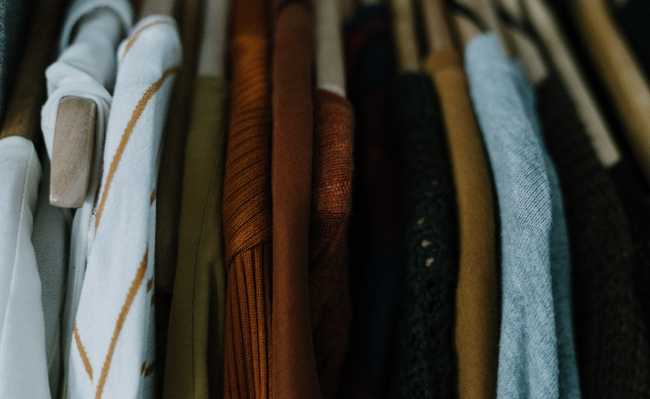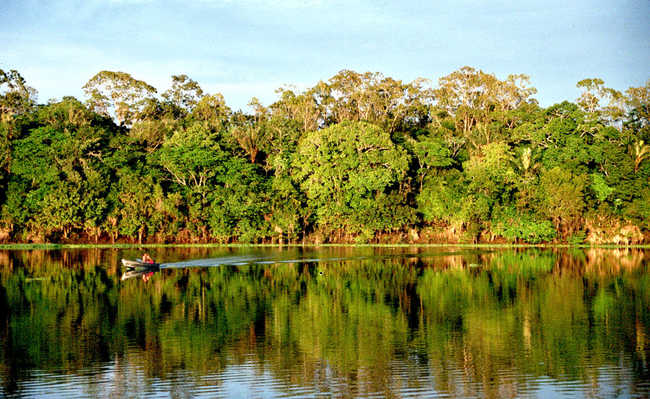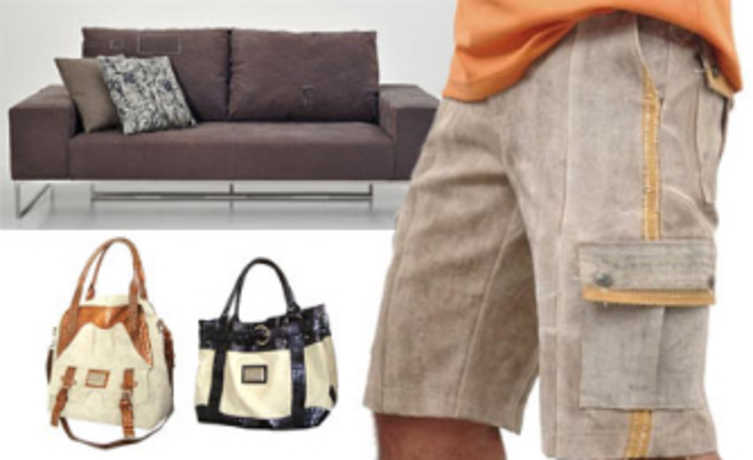Environmental impacts of textile fibers and alternatives
Textile industry pollutes atmosphere, soil and water, among other environmental impacts. Understand to make the best choice

Edited and resized image by Priscilla Du Preez is available on Unsplash
The environmental impacts caused by the textile industry depend on the type of textile fiber produced. However, even if there are differences in the types and levels of impacts generated according to the type of textile fiber produced (cotton, wool, viscose, bamboo viscose, tencel, polyamide/nylon, polyester, among others), there are always environmental impacts involved. Emissions come from transport, animal husbandry (in the case of wool and leather), the type of fiber used (polyester is derived from petroleum), water use and energy demand. Knowing the impacts of each type of textile fiber is essential to make the choice that best fits your profile, in order to prolong the life of the clothes.
Clothing has been a necessity that has been with humanity for a long time. In addition to the social function of differentiating cultures, professions and religions, clothing protects and shelters the human body from the wind, cold, sun and other external agents. In Brazil, the textile industry is very significant and involves several stages, such as fiber production, fashion shows, weaving, spinning, retail, etc.
Fiber types and environmental aspects
Each type of raw material goes through different processes until obtaining the textile fiber. And after making the cloth< it is necessary to apply chlorine, washing, dyeing, among other processes.
Fabrics have very different natures. We have the examples of leather, pineapple fiber, linen and many others... But among all types, the most used are natural fibers (cotton and wool), artificial fibers (viscose, bamboo viscose and lyocell /tencel) and synthetic fibers (polyamide/nylon and polyester). See how each type is produced and what its environmental impacts are:
cotton fiber
how is it done
Cotton gives rise to a type of textile fiber that represents more than half of the garments made in Brazil.
Once harvested (usually by machines), it goes through rollers that will remove its seeds, leaves and other unwanted materials, separating the material into bales. Then these fibers will be stored in spools and, after this process, placed on the loom to originate the cloth.
Environmental impacts
Despite using just over 2% of the total area devoted to agriculture, cotton production is responsible for around 24% of all insecticide consumption and 11% of agricultural pesticides.
In addition to the health problems caused by these insecticides and pesticides, cotton is responsible for byssinosis, a pulmonary dysfunction caused by the chronic aspiration of cotton fibrils.
Compared to synthetic fabrics, cotton consumes more energy, mainly for the fuel used by agricultural machines, tractors and for the energy of spinning machines and washing, drying and ironing processes.
Despite being of renewable origin, the degradation of soil and groundwater by conventional agriculture compromises its renewal.
Cotton fibers are recyclable, however, due to their short length, the process is difficult. The residues are used basically to make thick threads and strings.
Per kilo of cotton fiber produced, 7,000 to 29,000 liters of water are consumed in irrigation!
There
how is it done
The wool, which is nothing more than the natural protection produced by the sheep's body, is removed with scissors or clippers.
The clipping done by electric clippers is faster (around 5 minutes), however, the sheep are tied up, get stressed and get hurt a lot.
The manual way (with scissors) takes longer (around 15 minutes), but the sheep are calmer and are less injured.
After removal, the fleece (or fleece) undergoes a process to remove residues such as tallow, earth, leaves, etc. In this process, the wool is washed and potassium carbonate, hot water, soap and vegetable oils are added to soften the hair and facilitate combing.
To become fabric, the wool is twisted and stretched, giving rise to the yarn, which will later receive dyeing.
Environmental impacts
Due to the use of synthetic insecticides, wool production causes health problems, contaminates soil, water and fauna.
In addition, wool production emits significant amounts of methane gas (because of the sheep), detergents and grease.
Energy consumption, as well as in cotton production, is also greater than in the production of synthetic fibers, mainly due to the longer drying time required, the need for ironing and losses in the production process.
The use of water is also significant: to produce each kilo of wool about 150 liters of water are used.
Viscose
how is it done
Viscose is made from cellulose. It is produced from wood chips from trees that have little resin or from cotton seed. In the process, a cellulosic pulp is produced which is placed in contact with other fibers and extruded to give rise to the cellulose fiber.
- What is cellulose?
In the production of viscose, the biggest health problems are related to handling and contact with caustic soda and sulfuric acid.
Social and environmental impacts
Regarding the environment, the production of viscose emits carbon sulfide and hydrogen sulfide, two gases that have significant toxic effects.
Due to the high water absorption, the need for ironing and the low durability, the production of viscose has a high energy consumption.
In production, wood pulp or linter (a fiber that surrounds the cotton seed) is used as raw material.
For every kilo of viscose, 640 liters of water are used!
Despite being biodegradable (an environmental advantage), viscose fabric has low durability and recycling is complicated because viscose fibers are too short.
Bamboo Viscose
how is it done
Bamboo rayon is made from bamboo cellulose.
Environmental impacts
It has the same disadvantages as ordinary viscose: health problems caused by handling caustic soda and sulfuric acid; and carbon sulphide and hydrogen sulphide emissions. Despite this, the bamboo used in production grows without the need for pesticides or fertilizers, requires fewer machines for planting and manages to recover the soil, avoiding erosion.
On the other hand, bamboo viscose has a low durability and production requires high amounts of energy and water. To produce one kilo of the material, 640 liters of water are needed.
Lyocel/tencel
how is it done
Lyocell is a fiber obtained from cellulose of vegetable origin.
Environmental impacts
In the production process, N-methyl morphholine oxide is used, a biodegradable solvent that is considered ecologically viable because it is not toxic and can be reused in the process (99.5%).
By means of spin injectors, the cellulose is coagulated and then the fiber is washed, dried and later cut.
The amine oxide solution from the wash is purified by evaporation to remove water and recycled to the process.
In this type of production, energy consumption is high and the material has a low durability.
By using cotton linter as a raw material, lyocell carries the impacts of cotton planting and demands 640 liters of water for each kilogram produced. And despite being from a renewable source, lyocell is difficult to recycle for the same reason as cotton fiber: short fiber length.
Polyamide/nylon
how is it done
Polyamiamide material is a thermoplastic made from petroleum. It is usually found in carpets, shoes, watches, airbags, tents, etc.
Environmental impacts
Polyamide production has as a by-product water, hydrochloric acid and nitrous oxide, a gas that acts on the greenhouse effect.
A contribution of this material is for automobiles, as it is light, it allows a reduction in vehicle weight, which saves fuel. However, as it is a synthetic fabric, it can cause allergies.
Despite the higher energy consumption for production compared to natural fibers, there is a compensation over their useful life due to less waste in the chain, possibility of lighter products, greater durability and easier maintenance (easier washing, drying faster and does not need ironing).
The spinning waste is reused in the production of plastic, but despite being recyclable and having high durability, the production of polyamide fiber requires 700 liters of water per kilogram of material.
Polyester
How is done
Polyester is nothing but polyethylene terephthalate, better known as PET material. And PET is present in the most diverse objects of everyday life: clothes, plastic bottles, guitars, paints, canoes, upholstery, seat belts, cushion filling, duvets, varnishes and so on.
It can be obtained from oil or natural gas, non-renewable raw materials. The polyester in clothing is thermoplastic or thermoset, but most are thermoplastics.
The advantage of PET over natural fibers is that it guarantees a final product with less wrinkles, greater durability and color retention.
As a result, PET ends up being mixed with natural fibers to improve the quality of fabrics, combining the benefits of synthetic fiber with the softness of natural fibers.
As it is a thermoplastic, PET is recyclable. However, when mixing with natural fibers, recyclability ends up being unfeasible.
Environmental impacts
In the production of PET, volatile organic compounds (VOC) and effluents containing antimony are emitted. And just like polyamide, the large amount of energy consumed (compared to the production of natural fibers) is compensated over its useful life due to greater durability, greater ease of maintenance (easier washing, faster drying and no need ironing), less waste in the chain and more lightness.
Another environmental problem involving polyester is contamination via microplastics (small plastic particles less than a millimeter in diameter), which end up breaking loose from its fibers and end up in the oceans, harming ecosystems. Small animals feed on contaminated plastic and, along the food chain, end up spreading the poisoning to humans (find out more about the dangers of microplastics).
In one study, researchers found that, in a single wash, a polyester garment can loosen up to 1900 microplastic fibers.
For the production of each kilo of polyester, 20 liters of water are used. A very small amount compared to other fibers.
What type of fiber is most environmentally viable to consume?
First, we must remember that the best way to avoid environmental impacts is to extend the product's useful life, avoiding the consumption of new items. For more tips of this type, check out the article "How to impact less on the environment when buying clothes?".
Regarding the type of fiber, each has its pros and cons.
If you choose cotton products, focus on organic cotton fibers, avoiding the use of pesticides, herbicides, defoliants or synthetic fertilizers. Learn more about this topic in the article: "Organic cotton: what are its differences and advantages".
If you choose bamboo viscose fabrics (which have been considered an ecological alternative as they are advantageous over cotton and eucalyptus linter raw materials), remember: the filters that prevent the emission of polluting gases from this type of production are expensive and the textile industry ends up shifting its pollution (factories) to countries where regulation is weak, and Brazil is on this list.
Likewise, if you prefer synthetic fabrics (polyamide and polyester), thinking of the energy and water consumption advantages they bring, remember that they are products obtained from a non-renewable source, emit VOCs in production and even release microplastic into the ocean when they are washed at home.
If you choose recycled PET fabrics, prefer those that are not mixed with natural fibers to maintain the possibility of recycling.
But remember: synthetic fibers - which are present not only in clothes, but also in upholstery, bags, bed sheets, rugs, raincoats, fishing nets, etc. - are the main source of microplastic that contaminates our water, air, food, beer and environment. That's why it's best to avoid them. To understand more about this topic, check out the article: "There are microplastics in salt, food, air and water".
The best way to reduce the environmental impact of the clothes you buy is to inform yourself about each product you buy, abandoning it altogether. fast fashion and adopting the slow fashion. Understand these themes better in the articles: "What is slow fashion and why adopt this fashion?" and "Fast fashion: what it is, how it works and what environmental impacts it causes". A more environmentally friendly trend is the biotissue options, which is a material produced from vegetables, fungi and/or bacteria and has compostable characteristics. Learn more about this technology in the article: "What are biotissues".
If you cannot reuse your textiles, dispose of them conscientiously. See which collection points are closest to your home on the free search engine on eCycle portal. Lighten your footprint.










